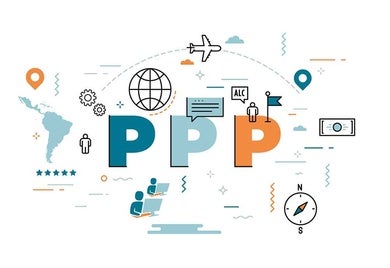
How to Measure Job Creation in Development Projects
Development finance institutions need to know how many jobs their investments support and create, yet obtaining reliable data is a challenge. To address this, IDB Invest is piloting a new framework to measure the contribution of development project portfolios to employment in Latin America and the Caribbean.

How can Anchor Companies Boost Access to Finance for Their MSME Suppliers?
Increasing access to alternative sources of financing for credit-constrained MSMEs is critical, and supply chain finance has emerged as a viable solution. Reverse factoring—whereby the supplier sells its invoices to a financial intermediary for fast cash, and the buyer guarantees payment of these invoices—shows particular promise.

Can Digital Credit Boost E-commerce among MSMEs?
Reaping the rewards of e-commerce is a challenge for many MSMEs. The solution may lie in the so-called “digital credit” offered by fintech companies within commercial platforms that bypass traditional banks.

TechFins, MSMEs and ecommerce are reshaping the economic development of the LAC region
First it was the FinTechs. Now, TechFins and their expansion through MSMEs lead a new digital economy in Latin America and the Caribbean.

SMEs and the Challenge to Export
Small and medium-sized enterprises (SMEs) are an essential part of a dynamic and healthy economy. Their increase in number and growth advances competition and strengthens the entrepreneurial ecosystem, with a positive and significant impact on innovation and aggregate productivity. SMEs represent close to 90% of the companies in a typical Latin American or Caribbean country and employ most of the labor force (close to 70%). They also tend to create a substantial portion of new jobs; although many of these jobs do not survive, the net effect tends to be positive. However, the region’s SMEs show a low level of internalization (learning by doing) compared to their peers in the developed countries or other emerging economies, or even compared to large companies in the same sector and country. Exporting: Relevance and challenge There is abundant evidence showing that Latin American and Caribbean countries are behind developed countries, due to the productivity gap. Improving productivity is essential for the region’s economies and expanding exports can help. First, international trade produces a reallocation of resources from less productive companies and sectors to more productive ones. Second, by exporting companies learn (learning-by-exporting) and innovate, which is reflected in significant efficiency gains. Finally, international trade affects the incentives for investment in activities that promote technological dissemination and generates spillover effects in international knowledge. However, companies face many obstacles when they try to enter external markets. They have to contact clients abroad, identify business opportunities, learn about distribution channels and administrative procedures, among other aspects. All these activities generate a wealth of information that can be used by other companies at no additional cost (or lower cost). This scenario generates a problem of free riding in the search for foreign buyers, given that the pioneer uncovers highly valuable information that can be used by other companies to imitate their behavior. In this context, where the private returns of the forerunners are less than the social returns, market incentives tend to lead to a suboptimal level of investment in the exploration of international markets. Thus, the existence of information externalities can negatively affect companies’ internalization process and provides a key rationale for encouraging companies to export. It’s even more difficult for SMEs In addition, SMEs in Latin America and the Caribbean tend to face restrictions in various areas of business — due to various market failures and failures in coordination — limiting their internalization. These areas are primarily access to credit, the intensity of innovation, capacities (human capital) and the organizational structure. SMEs in the region have limited access to credit, due to information asymmetry problems — financial institutions usually do not have the information they need to evaluate and monitor SMEs’ projects, which can cause problems of moral hazard — but also because financial products are not suited to SME needs, particularly due to scale problems related to the fixed costs of the lending process and the lack of long-term financing. In addition, SMEs generally do not have (sufficient) collateral, while their access to credit is highly dependent on collateral and not so much on expected returns as in the case of large companies. The nature of knowledge as a public good, information asymmetries and the lack of coordination particularly limit SMEs’ innovation and competitiveness both domestically and internationally. On the other hand, these companies tend to lack capacities — qualified and experienced personnel — for the export process: identifying, selecting and obtaining information on external markets, designing and implementing marketing strategies, and developing contracts overseas. SMEs have limited knowledge on exportable products and the underlying factors that determine international competitiveness (e.g., packaging, quality regulations, standards, etc.). Also, SMEs face other specific barriers specific related to export activities such as language, paperwork, billing, and sales management. Lastly, SMEs have characteristically weak corporate governance and management and business structures even though in most cases these are companies with personalized and traditional organizational hierarchies linked to a single owner or family. All these factors profoundly limit the export capacity and competitiveness of these companies. A model helping Argentine SMEs to export In 2002, the Fundación Banco Credicoop, with support from the IDB Group, created the Diverpymex program. The objective of this program is to help non-exporting SMEs to successfully enter export markets and exporting SMEs to increase their exports, whether through consolidation and/or diversification. The program consists of three stages that consider the phases in the export development process: Evaluating the company’s export potential: Analyze its skills and competence for operating in international markets. A program coordinator and a consultant visit the company and gather information on its organization, operations and products, and hold meetings with the managers to evaluate the company’s entrepreneurial spirit in terms of export activities and potential commitment to incorporate an intern (in the absence of qualified staff) and to make the investments necessary to develop its exporter profile. Developing an export plan: The company, with technical assistance from the consultant, researches and selects potential markets and clients, and decides which are best suited to them. It also establishes objectives, develops a budget, plans how the exports will be managed, and analyzes financial, logistical, and staffing requirements, as well as other aspects of the export process. Implementing the plan: The company undertakes planned actions in foreign markets. At this point, training and technical assistance activities are carried out on specific subjects that arise during the process of market penetration such as shipments and insurance, quality and environmental standards, design and packaging, marketing channels, tax legislation, and others. How do we evaluate the impact and what have we learned? In a recent study done by IDB Invest, we evaluated the Diverpymex program’s impact on SME’s export behavior, growth and productivity. The study analyzes the dynamics and sequence of the effects, allowing for inferences regarding the mechanisms through which the program affects the companies’ performance. What were the main results? The program has a positive and significant impact on SME’s export behavior, growth and productivity. The positive effect on the likelihood of exporting and entering new markets is significantly greater in the short term, which confirms the importance of high costs for entering foreign markets. The positive effect on the amount of exports, for companies that were already exporting, appears over the medium term, and it is related to the resolution of more specific information barriers to markets and products, allowing these companies to grow and consolidate their efforts in export markets. Finally, the program increases the company’s productivity in the long term, indicating that SMEs achieve efficiency gains due to a learning-by-exporting process. Subscribe to receive more content like this! [mc4wp_form]

Tourism development through PPPs: An opportunity to generate employment in Latin America and the Caribbean?
Tourism is one of the world’s largest industries, particularly in terms of employment. This industry generates one out of every 11 jobs in the world, represents 10% of gross domestic product (GDP) worldwide, and 7% of exports, according to the World Tourism Organization. International arrivals around the world grew from 25 million in 1950 to more than one billion in the last few years, a period during which arrivals in developing countries exceeded those in developed countries. But what are the characteristics of employment in this industry? Why are coordinated public-private investments needed? How can we measure the impact of an investment in tourism on employment? Does investment in tourism always have positive effects on employment? Tourism and employment One of the main reasons why the developing countries are so interested in the tourism industry is its job creation potential. Expansion of the tourism industry generates direct, indirect, and induced jobs. Besides, it is a diverse and labor-intensive sector, and thus an effective generator of a wide range of job opportunities. Tourism employs more women, young people, and people with limited education than most industries, promoting an environment of inclusion and empowerment for vulnerable groups. In addition, given its low barriers to entry, this industry provides investment opportunities for entrepreneurs to start small-scale businesses and hire workers. The need for coordinated public-private investments The economic benefits of tourism do not usually reach their optimum (social) level with isolated private sector investments alone. The geographic concentration — dependence on natural and/or cultural attractions — and goods and services complementarities characteristic of this industry highlight the importance of factors like economic agglomeration effects, spillover effects, and externalities. In this context, investment decisions are interrelated so the potential benefit of a specific investment depends on the complementarity of other investments. Thus, without adequate coordination among investors, the market fails to allocate resources optimally. For example, hotel owners may under-invest in hotel capacity as their returns depend on the investment decisions made by restaurant owners and other investors in recreational and cultural activities. Similarly, public investment in infrastructure for transportation and tourism — such as roads, lighting, restoration of the historical and cultural heritage, among other investments — is limited by lack of coordination with the private sector, to generate an adequate flow of tourists. A recent experience in Latin America and the Caribbean Between 2003 and 2010, the government of the province of Salta implemented a series of interventions to generate a structural change in the tourism industry and create jobs after Argentina’s economic crisis in 2001. These investments required a high degree of coordination and collaborative frameworks to foster public-private partnerships (PPPs). The initiative was also supported by a loan from the Inter-American Development Bank (IDB) Group. The Tourism Development Policy (PDT, by its Spanish acronym) was based on three pillars: i) construction and modernization of the transportation and tourism infrastructure; ii) tax incentives for the construction, expansion, and remodeling of hotels and other types of lodging; and iii) institutional strengthening of tourism entities and a comprehensive and sustained national and international advertising campaign. How do we evaluate tourism’s impact on employment and what are our findings? In a recent study conducted by the IDB Group, we evaluated the impact of the PDT on employment using a methodology known as the Synthetic Control Method. Specifically, we used a weighted combination of other Argentine provinces to construct a ‘synthetic leap’ that reproduces what would have happened with employment in the absence of the policy. What were our main findings? The PDT created 1,376 new jobs in the tourism value chain of Salta province between 2003 and 2013. Fifty percent of this growth was led by the hotels and lodging sector. The PDT did not displace employment in other industries. On the contrary, it produced spillover effects and positive externalities in employment. For every job created in the tourism value chain, a new job was created in the rest of the economy. This means a total of 3,750 new jobs in Salta’s economy. So, does every investment in tourism have a strong positive impact on tourism? Not necessarily. Although an increase in tourism services supply and demand may benefit other industries, both through direct and indirect spending and multiplier effects, it may also produce displacement (crowding-out) effects. These latter are negative effects that may occur in other sectors, due to restrictions on the supply of labor, capital, or land. The effect in employment may be negative if the increased demand in labor generates higher salaries and captures employees from other sectors; this means, if employment in tourism grows at the expense of a reduced employment in other industries. This did not happen in the case of Salta, due to regulation of the minimum salary in all industries, and the high level of unemployment, characteristic of the province during that period. Similarly, no negative effects were anticipated due to pressure on other supplies prices (cost of capital and land) or reduced competitiveness in export or import markets through appreciation in the exchange rate. This was possible in the case of Salta given its industries’ low capital intensity, significant amounts of available land, and limited influence on the exchange rate, added to the devaluation context affecting Argentina at the time. Due to Salta’s characteristics and specific context, and the comprehensive public-private approach of the PDT, the positive multiplier effects of investments in tourism offset the negative effects; moreover, resulted a significant increase in total employment, above and beyond the tourism industry itself. Subscribe to receive more content like this! [mc4wp_form]